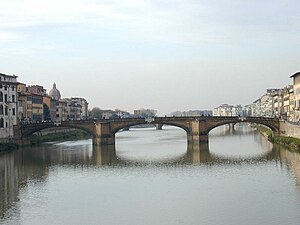Ponte Santa Trinita
Coordinates: 43 ° 46 ′ 9 ″ N , 11 ° 15 ′ 1 ″ E
| Ponte Santa Trinita | ||
|---|---|---|
| use | Road bridge | |
| Crossing of | Arno | |
| place | Florence | |
| construction | Basket arch bridge | |
| overall length | 100 m | |
| width | 11.5 m | |
| Number of openings | three | |
| Longest span | 29 + 32 + 29 m | |
| start of building | 1567 | |
| completion | 1571 | |
| planner | Bartolomeo Ammanati | |
| location | ||
|
|
||
| Basket bow | ||
The Ponte Santa Trinita is a road bridge over the Arno in Florence . The building from the Renaissance is considered to be one of the most beautiful bridges in Italy and is counted among the most elegant structures in Europe .
Name, location
The Ponte Santa Trinita got its name from the nearby Chiesa della Santa Trinita (Church of the Holy Trinity ) . It lies below the Ponte Vecchio and above the Ponte alla Carraia . It connects the Piazza Santa Trinita with the Piazza de 'Frescobaldi and the Palazzo Spini Feroni in the north with the Palazzo della Missione in the south of the city.
description
The Ponte Santa Trinita is the oldest basket arch bridge in the world and, thanks to its innovative arch construction, has a previously unattainable flat profile (ratio of span to arch height of 7: 1). Its middle arch has a span of 32 m, the two outer arches of 29 m each. The wide curved arches contrast with the massive pillars, which comply with the rule, which has long been regarded as binding, that the pillar thickness must be around a fifth of the span of the bridge arch.
The building was made of the yellowish-brown, Florence-typical Pietra Forte . In addition to its elegant arch construction, the bridge stands out for its sharply cut abutments, which prevent the entanglement of tree trunks during floods, as well as the white cartouches and the four allegorical figures on the corners that represent the seasons: erected in 1608, two are the work by Pietro Francavilla ( spring and winter ), the other two by Giovanni Caccini ( summer and autumn ); they celebrate the wedding of Cosimo II to Maria Magdalena of Austria .
history
A wooden structure was built in 1252 under the patronage of the Frescobaldi family . However, this bridge collapsed after a few years (1259) under the weight of a crowd attending a spectacle on the Arno. Rebuilt in stone, it gave way to the pressure of the great flood of 1333, which only spared the Ponte all grace . The reconstruction was slow and took over fifty years in total, from 1356 to 1415.
The renewed destruction in 1557, again due to flooding, made today's construction possible, which was built between 1567 and 1571. The project, commissioned by Cosimo I de 'Medici , came to Bartolomeo Ammanati , but seems to have been accompanied in the drawing and construction by Michelangelo , who may have suggested the modern line of three elliptical arches that emerged in his studies on the occasion of the Medici -Capels and the staircase of the vestibule of the Biblioteca Medicea Laurenziana . This arch shape with outwardly increasing curvatures is an invention that anticipated the Baroque and also brought great technical progress.
The bridge was destroyed on August 4, 1944 by German troops in retreat, made temporarily usable again by the British Army with a Bailey Bridge and rebuilt in the same style between 1952 and 1958. In particular, the four statues were salvaged from the river, only the head of the spring statue was not found again until 1961 .
Web links
- Ponte Santa Trinita. In: Structurae
- Ponte Santa Trinita on bridge web
Remarks
- ↑ The name of both the church and the bridge is stressed on the first syllable in the Florentine style and written without accento grave .
- ↑ This fifth rule was still applied 150 years later, e.g. B. described by Hubert Gautier in his long authoritative treatise on the construction of bridges Traité des ponts (Paris, 1728).
- ↑ The basket arch constructed with the help of several circle centers with decreasing radii has nothing to do with the chain line or the similar parabola .







